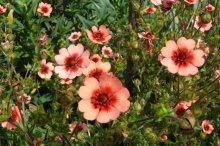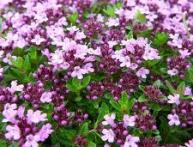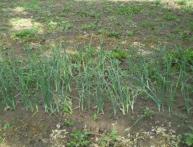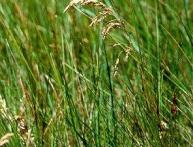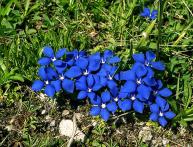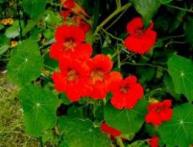Nepalese cinquefoil, description of the plant, planting and caring for it
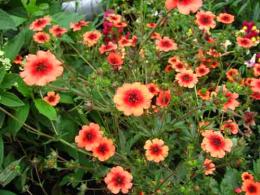
There are many simple, but quite pleasant and easy to care for decorative plants. These are the kind of garden inhabitants that most gardeners dream of. One of these plants is cinquefoil. In the Rosaceae family, the Cinquefoil genus is one of the most numerous in terms of the number of species and varieties. Nepalese cinquefoil deserves special attention.
Content:
- Beautiful guest from Nepal - Nepalese cinquefoil
- Where to plant Nepalese cinquefoil
- Reproduction and planting of Nepalese cinquefoil
Beautiful guest from Nepal - Nepalese cinquefoil
The genus Cinquefoil has grown significantly in recent years after it included plants previously considered separate genera. This also applies to varieties such as strawberries. This expansion became possible after studying DNA. The genus Cinquefoil includes such life forms as:
- bushes
- subshrubs
- herbaceous perennials
- herbaceous annuals
Nepalese cinquefoil is a herbaceous perennial. The name of the plant speaks of its homeland - Nepal, the Himalayas. This flower rarely exceeds 50 cm in height. The stems of the plant have good branching. The leaves are palmate, up to 30 cm in length, the color of the leaf blades is green.
The flowers are quite large. On average, their size is 3 cm. The color of the flowers is pink or light pink with darker almost red veins or the middle and beautifully located stamens.The calyx of the leaf almost always consists of five, less often four, petals with a notch.
Flowers are solitary or collected in paniculate inflorescences. The plant is unpretentious, withstands severe frosts down to -30. It forms many varieties and hybrid forms. Nepalese cinquefoil and its varieties are in demand in garden design due to their long flowering period. Almost all of them begin to bloom in the third decade of June and continuously delight the eye with flowers until the end of August.

Nepalese cinquefoil varieties deserve special attention for their decorative properties:
- variety Roxana - flowers are large, orange, with a salmon tint and dark, narrow veins
- variety Flower Carpet - low, lush bushes with coral-colored flowers, characterized by a long flowering period, which begins in mid-June and lasts until mid-September.
- variety Floris, coral-colored flowers with a dark, purple center, from which thin veins extend;
- variety Miss Wilmont, cherry-colored flowers with a darker eye in the middle
The purposes in landscape design are very diverse. Suitable for group and single plantings. Nepalese cinquefoil is an excellent plant for decorating borders and alpine hills. Planting cinquefoil in the garden is quite simple, but first you need to choose a place.
Where to plant Nepalese cinquefoil
Considering that under natural conditions the plant feels good in open sunny areas with fairly poor soils, finding a place in the garden that is suitable for Nepalese cinquefoil will not be too difficult.
It is best to choose a well-lit place for Nepalese cinquefoil. It is desirable that the period of continuous illumination per day be at least 6 hours. A little partial shade is also suitable for the plant.In denser shade, the cinquefoil will bloom, but the growth of the bushes will slow down.
Video about cinquefoil:
Potentilla is completely undemanding to the chemical and mechanical composition of the soil. It is optimal to place it in areas with loamy or sandy loam soils, with a slightly acidic or slightly alkaline reaction. Grows well in fairly poor soils, but responds well to the addition of organic and mineral fertilizers. fertilizers, in this case the flowers may become larger and brighter.
The plant is resistant to negative winter temperatures. It perfectly withstands frosts down to -30. It does not require special shelter for the winter in most areas, not only in the center of the country, but also in Siberia and the Far East. The vegetative parts begin to grow in mid-April, when the average daily temperature does not fall below + 7 + 8, and continues until mid-October.
Nepalese cinquefoil prefers moist but well-drained soils without stagnant water. In the first month after planting, it requires regular additional watering. In very dry weather, water additionally once every three to four days. If the place is chosen, then all that remains is to plant Nepalese cinquefoil.
Reproduction and planting of Nepalese cinquefoil
Cinquefoil reproduces both by seeds and vegetative parts:
- cuttings
- offspring
- dividing the bush
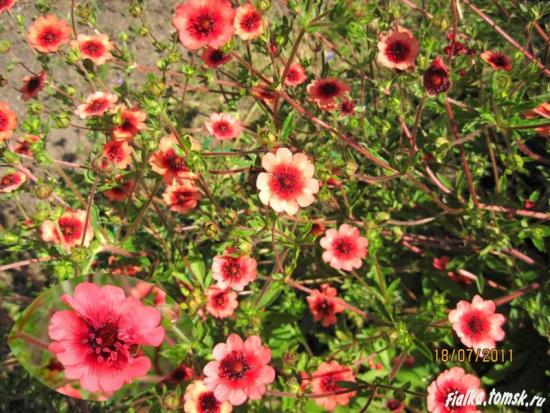
For growing From seeds they can be sown either directly into the ground or through growing seedlings. To sow seedlings, the planting boxes are filled with soil, which contains equal parts of garden soil, sand and peat. The soil is moistened. The seeds are laid out on the surface and sprinkled with a thin layer of earth or sand. Everything is covered with glass to preserve moisture.After 14 days, shoots appear, at this time the sprouts need to be provided with watering once every 2 - 3 days and a temperature of +18.
After about 45 - 60 days, the cinquefoil can be planted in the ground. When sowing in the ground, this can be done as early as mid-May. Potentilla seeds are sown on moist soil and sprinkled with a 2-3 mm layer of sand. After the emergence of seedlings, they are provided with regular watering and weeding during the first month. They are planted in a permanent place in late summer - early autumn.
Young plants will bloom next season. After four years, the bush will have grown and can be divided. The cuttings are planted immediately in a new place at a distance of 0.6 -0.8 m.
Prepare a planting hole measuring 50 by 60 cm and fill the bottom with drainage material. Take 20 - 30 grams of mineral fertilizers and mix them with the soil and place them on top of the drainage. After which the seedling is installed, the roots are covered with soil, tamped lightly. Watered with water and mulched with peat or humus. Further care is the same as for seedlings. All care comes down to timely removal weed, to watering and loosening, especially in dry seasons.
Nepalese cinquefoil needs to be fed three times a season. The first feeding is carried out in the spring after the soil has thawed, the second - at the end of May, the third - at the beginning of September. If there is a need, then once every three years the Nepalese cinquefoil bushes can be cut. Thus maintaining the neat appearance of the plant and stimulating abundant flowering.

